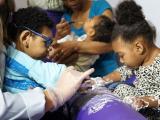Since Zika virus (ZIKV) infections erupted in Brazil in 2015, several studies have attempted to quantify the likelihood of birth defects, including microcephaly, in Zika-affected pregnancies. A prospective cohort study published today in the New England Journal of Medicine (NEJM)shows that 7% of all pregnancies with laboratory confirmed Zika infections had evidence of a Zika-related birth defect.
The study's findings are similar to results from a study of birth outcomes in US territories published by the Centers for Disease Control and Prevention (CDC) last June. That study found 5% of babies born to women with confirmed Zika had birth defects.
The current study is based on data collected from French territories (Guadeloupe, French Guiana, and Martinique) in the Americas. Researchers followed 546 pregnancies from March through November of 2016. All mothers had confirmation of Zika infection in pregnancy and were symptomatic. The 546 pregnancies produced 527 live births and 28 that were not carried to term or were stillborn.
Thirty-nine, or 7% of the fetuses and infants, had signs of neurologic and ocular defects associated with Zika infection. Of those, 10 fetuses were aborted for medical reasons, 1 was stillborn, and 28 were live-born. Microcephaly was detected in 32 of the 39 fetuses and infants.
Though a risk of possible Zika-related birth defects existed regardless of when a mother contracted the virus, the risk was much higher in the first trimester of pregnancy, a finding also seen in the US study.
"The risk of birth defects was 12.7% when ZIKV infection occurred in the first trimester, 3.6% when it occurred in the second trimester, and 5.3% when it occurred in the third trimester, and the risk of the congenital Zika syndrome was 6.9%, 1.2%, and 0.9%, respectively," the authors concluded.
While findings from the French and US territories are similar, a Brazilian cohort study published in 2016 showed a much higher percentage of affected births: 42%.
The authors of today's study suggest that discrepancy is caused by wider neurologic defects considered in the Brazilian study. Rates of microcephaly, the most feared and severe Zika outcome, were roughly the same among US, Brazilian, and French territory cohorts (3.4% to 5.8%). But the Brazilian study included MRI imaging results that captured a broader range of neurologic outcomes.
Risk among asymptomatic pregnancies still unknown
In a NEJM commentary on the new study, Margaret Honein, PhD, MPH, of the CDC's National Center on Birth Defects and Developmental Disabilities, said that although the study is a useful guide for pregnancies with confirmed, acute, maternal Zika infections, there is still a gap of knowledge about the overall risk of Zika birth defects in parts of the world where the virus is endemic.
"While it seems we have been talking about Zika for awhile, we're really just at the beginning of understanding this virus," Honein told CIDRAP News.
Honein said it was very reassuring that the French territory data so closely aligned with US surveillance data. She reiterated that the rates of microcephaly have been similar in all studies based on the recent outbreak in the Americas.
About 80% of Zika infections go undiagnosed because they are asymptomatic or produce only mild flu-like symptoms.
"Population-level increases in ZIKV-associated birth defects are unlikely to be recognized without ongoing timely and comprehensive surveillance of birth defects that captures all affected fetuses and infants regardless of whether maternal ZIKV exposure or infection was identified," Honein wrote in the commentary.
Ongoing surveillance will help detect Zika outcomes not present at birth, including hearing loss, learning problems, and a range of other possible defects, Honein said in the interview.
See also:
Mar 14 NEJM study
Mar 14 NEJM commentary
Jun 8, 2017, CIDRAP News story "CDC notes 5% rate of Zika birth defects in US territories"
Dec 14, 2016, CIDRAP News story "Two studies highlight risk of fetal Zika damage"






















